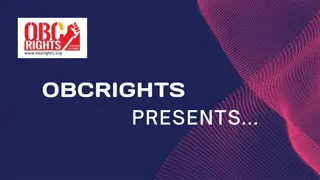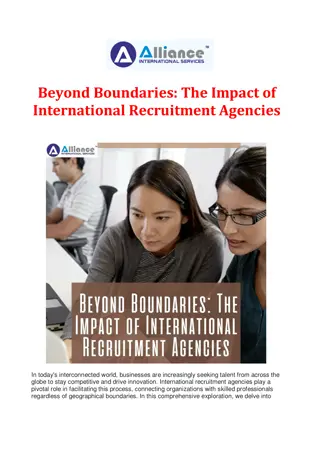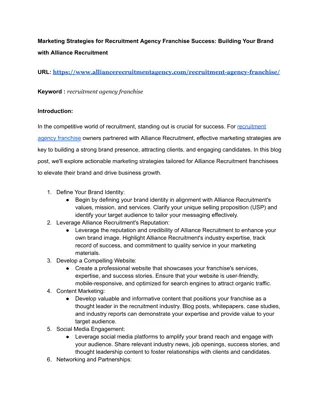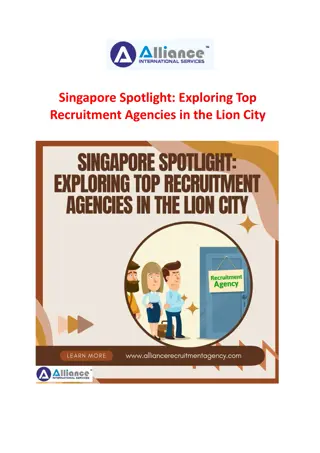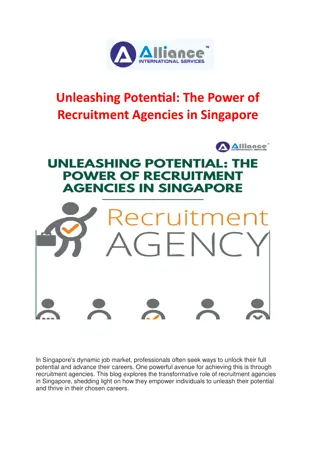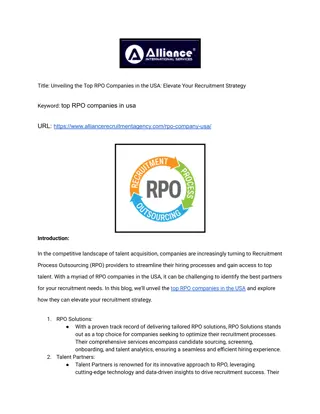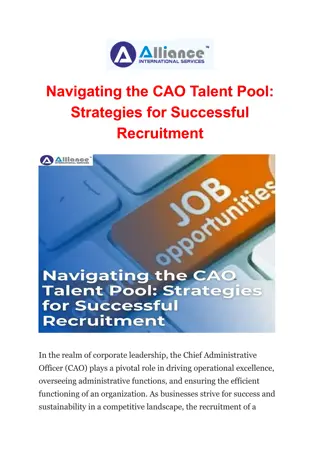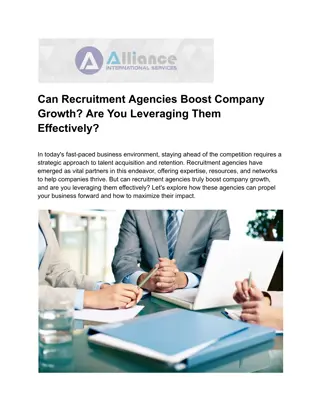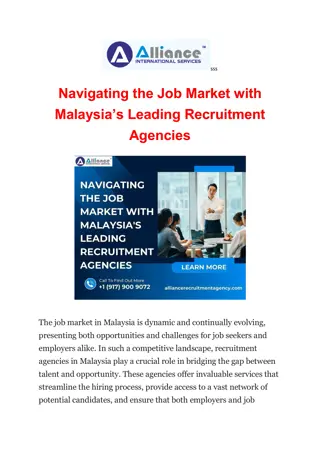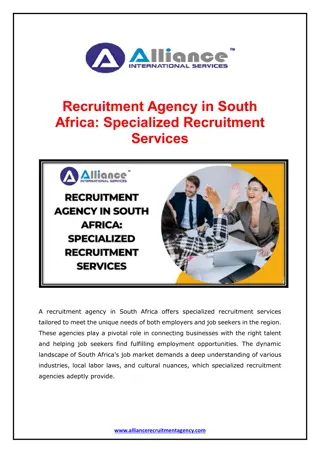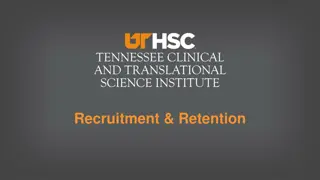
Effective Recruitment Strategies for Organizations
Recruitment is a vital process in organizations to attract qualified candidates for job vacancies. It involves various sources like internal promotions, transfers, and external recruitment methods. By utilizing these strategies effectively, organizations can enhance employee performance, motivation, and loyalty.
Download Presentation

Please find below an Image/Link to download the presentation.
The content on the website is provided AS IS for your information and personal use only. It may not be sold, licensed, or shared on other websites without obtaining consent from the author. If you encounter any issues during the download, it is possible that the publisher has removed the file from their server.
You are allowed to download the files provided on this website for personal or commercial use, subject to the condition that they are used lawfully. All files are the property of their respective owners.
The content on the website is provided AS IS for your information and personal use only. It may not be sold, licensed, or shared on other websites without obtaining consent from the author.
E N D
Presentation Transcript
Recruitment publicizing information about various job vacancies in the organization. It is a process of searching for prospective employees and encouraging them to apply for the job in the organization. Recruitment is a positive process because it stimulates people to apply for the job. It is an important part of staffing, and it is also an ongoing process. Its main aim is to attract a large number of qualified candidates to apply for the job. For this purpose, an organization communicates the vacant position through different sources of recruitment. This process of staffing brings together the job giver and the job seekers. can be defined as the process of
Recruitment is performed to attract potential employees with the necessary qualifications and skills in the adequate number for the positions available in the organization. It searches available people for the job and invites them to apply for the job. The process of recruitment precedes the process of selection of the right candidate for the given positions in the organization. Recruitment seeks to attract suitable applicants to apply for available jobs. The Identify different sources of labour supply for which applications of prospective employees may be obtained. Evaluate the validity of different sources. Choose the most suitable source or sources. Contact applications. Attract and motivate prospective candidates to apply for vacant jobs. The recruitment recruitment process process involved involved the the following following activities activities: the chosen sources of recruitment to secure
An organization can recruit employees from within or from outside. Therefore, the various recruitment sources available to an organization may be broadly divided into two categories: Internal I I. . Internal Internal promotions. Transfers one department to another, or from one shift to another without any significant change in a person s responsibility, status, or pay. In some cases, it may bring about some changes in responsibilities, or working conditions, but it cannot result in a change in the salary of the employee. Transfer can help fill vacancies with employees from departments that are over-staffed. It is the horizontal movement of employees. If employees are insufficient in one branch or department, it can be filled through transfer. It is also important in avoiding termination and helping solve the employee s problems. During the transfer, it should be kept in mind that the employee who is transferred to another job is capable of performing it. Transfer also helps the employees learn about different jobs as well. Promotions employees from a lower level to a higher position. It is the movement of employees from a lower level to fill in the vacancy of a higher authority. Promotions influence the employees greatly as a promotion at one level leads to a chain of promotions in the levels lower than it. Internal and External External sources. Internal Sources recruitment Sources consists of two main resources that are transfers and Transfers: : Transfer refers to the moving of an employee from one job to another, Promotions: : In most business organizations, there is a practice of promoting the
Internal recruitment or filling vacancies within the organization have the following advantages. Higher boost their performance. Promotions at a higher level lead to a chain of promotions at the lower levels. This also increases their status and pay, and motivates the employees to improve their performance. This increases their motivation and commitment to the organization. The employees, thus remain loyal and satisfied with the organization. Simple placement simple. The working of the employees can be evaluated in a better way. This type of recruitment is better as the employees know about the organization well. Develops employees are trained for higher jobs. The people who are transferred within the organization do not need induction or orientation training. No organization can shift employees from one department to another where there is a shortage. Economical comparison with external sources. Higher Motivation Motivation level level: : Internal recruitment may help the employees to Simple Process Process: : Internal recruitment makes the process of selection and Develops future future managers managers: : Transfer is a method through which No over over or or under under staffing staffing: : Another benefit of transfers is that the Economical: : The process of internal recruitment is cheaper in
The limitations of internal sources are as follows: Lack of getting fresh talents. Therefore, being completely dependent on internal sources can give rise to the danger of inbreeding by not letting new people join the organization. Decrease lazy because they know that they will be promoted. Low hampered due to the frequent transfer of employees. Lack and spirit of competition as there is no competition from the outside world. Limited vacancies through internal sources of recruitment, especially new organizations. Lack of of fresh fresh talent talent: : The internal sources reduce the opportunity Decrease in in enthusiasm enthusiasm level level: : The employees tend to become Low productivity productivity: : The productivity of the organization may get Lack of of competition competition: : The employees may lose their motivation Limited choice choice: : All the organizations cannot fill in all their



